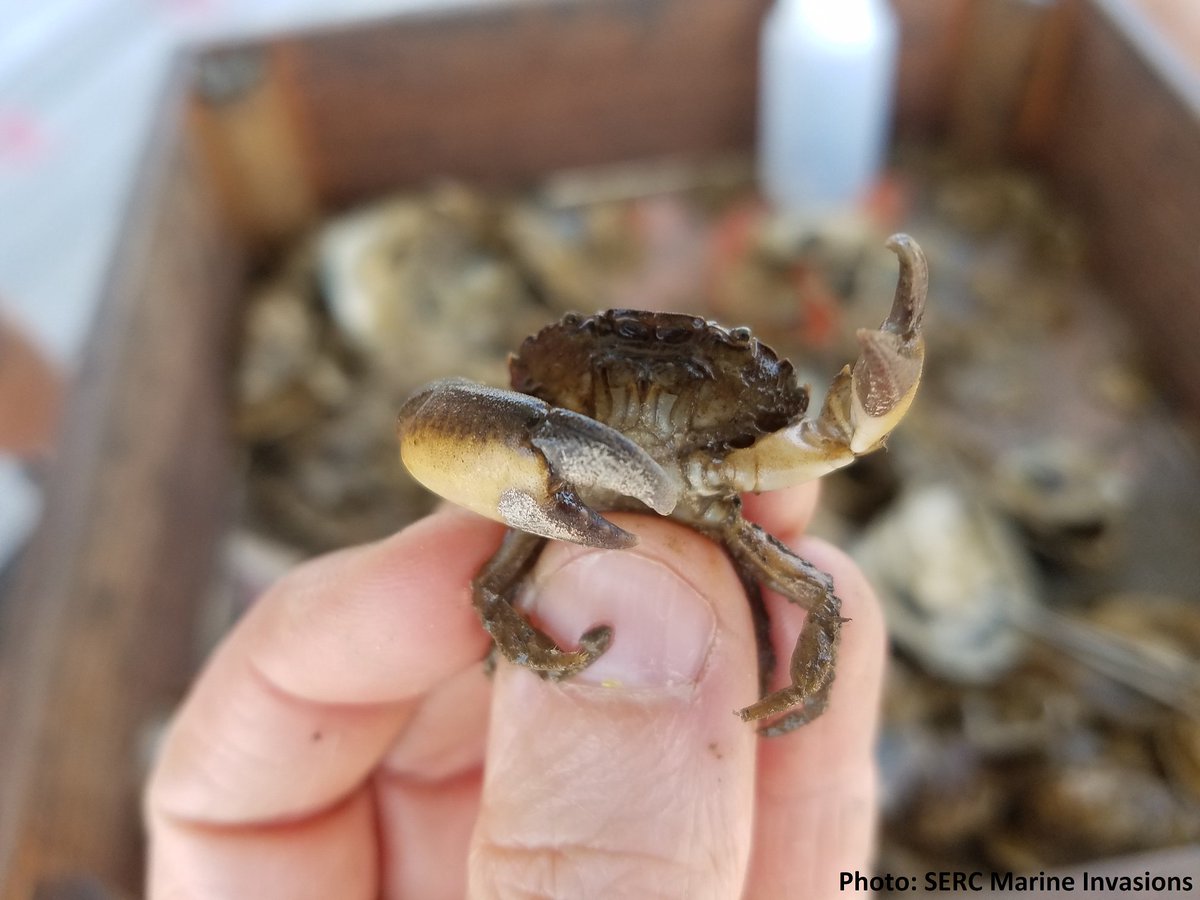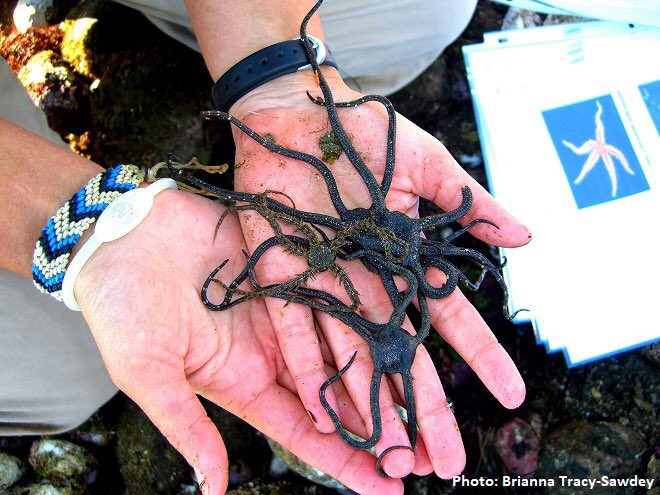Discover and read the best of Twitter Threads about #nisaw
Most recents (9)
To wrap up National Invasive Species Week – let's explore one of our favorite invaders: Loxothylacus panopaei, the body-snatching parasite. #NISAW #ZombieCrabs (1/6) 

The parasite, which is technically a barnacle, takes over a crab and turns it into a #ZombieCrab. Loxo infects and assumes control over a host crab, controlling major functions such as molting and reproduction as well as compromising the crab’s immune system. (2/6) 

Loxo can take over at least 9 different kinds of crabs – including the white-fingered mud crabs in the Chesapeake Bay! #NISAW #ZombieCrabs (3/6) 

The encrusting #bryozoan (Watersipora sp.) is giving our taxonomists a headache! Through genetics, we've discovered what we thought was one species is actually MULTIPLE & they cannot be identified by morphological characters alone! #InvasiveSpecies #NISAW (1/6) 

One species, Watersipora subtorquata complex, is wide spread as an #InvasiveSpecies across the globe. However, we have a poor understanding of its native region since it has been so often confused with several other species! #InvasiveSpeciesWeek #NISAW (2/6) 

To make things even MORE confusing, there are multiple clades of the Watersipora subtorquata species! A clade is a group of organisms with the a common ancestor on its family tree. #InvasiveSpeciesWeek #NISAW (3/6) 

#DYK one of the most voracious ocean predators is the sea star? Most species are generalist predators, eating mollusks, crustaceans, bivalves, microalgae, and other echinoderms. Acanthasteridae, commonly known as the Crown-of-Thorns seastar, will even feed on coral polyps! (1/5) 

The Northern Pacific sea star (Asterias amurensis) was named one of the world’s 100 worst #InvasiveSpecies. These stars will eat almost anything causing huge economic consequences – the Tasmanian fishing industry alone has suffered an estimated billion dollar loss! #NISAW (2/5) 

Another invasive sea star - Savigyi’s Brittle Star (Ophiactis savignyi B) - is considered the world's most common and widely distributed. This #BrittleStar commonly inhabits marine #FoulingCommunities and has been found on ships' hulls, buoys, and marine structures. (3/5) 

To celebrate #InvasiveSpeciesWeek - we will be highlighting a prolific invader every day this week! Today's organism? The solitary #tunicate - Ciona savignyi! #InvasiveSpecies #NISAW (1/4) 

This #invasive tunicate is originally native to Japan with introduced populations first reported on the West Coast of North America in 1985. #InvasiveSpeciesWeek #NISAW (2/4) 

Ciona savignyi is often found on our #FoulingProject panels in large abundance alongside C. robusta - as you can see in the picture! Its tunic is transparent & yellowish-green in color and soft & gelatinous to the touch. #InvasiveSpeciesWeek #NISAW (3/4) 

Our final invader to highlight this week is the Japanese Skeleton Shrimp (Caprella mutica)! 🔎 #InvasiveSpecies #InvasiveSpeciesWeek #NISAW (1/5) 

Caprella mutica is a #caprellid amphipod that is native to the Northwest Pacific and to the East and West coasts of North America, Europe, Africa, and New Zealand. #InvasiveSpecies #InvasiveSpeciesWeek (2/5) 

Caprellids are capable of long-distance dispersal on floating seaweeds or other marine debris. Other vectors include ballast water, ship fouling, and the culture of the Pacific oyster (Crassostrea gigas). #InvasiveSpecies #InvasiveSpeciesWeek (3/5) 

The encrusting #bryozoan (Watersipora sp.) is giving our taxonomists a headache! Through genetics, we've discovered what we thought was one species is actually MULTIPLE & they cannot be identified by morphological characters alone! #InvasiveSpecies #InvasiveSpeciesWeek (1/6) 

One species, Watersipora subtorquata complex, is wide spread as an #InvasiveSpecies across the globe. However, we have a poor understanding of its native region since it has been so often confused with several other species! #InvasiveSpeciesWeek #NISAW (2/6) 

To make things even MORE confusing, there are multiple clades of the Watersipora subtorquata species! A clade is a group of organisms with the a common ancestor on its family tree. #InvasiveSpeciesWeek #NISAW (3/6) 

We’re celebrating #InvasiveSpeciesWeek and #WormWednesday with today’s highlight: BAITWORMS! #DYK that polychaete baitworms and marine algae ("wormweed") are harvested and shipped via overnight mail to bait shops across the globe? #InvasiveSpecies (1/4) 





Most of the organisms sold for bait are packed in algae. This algae, which also may be unintentionally introduced, may have species living in and on it that can be introduced when that algae is discarded in the water. #InvasiveSpeciesWeek #NISAW #InvasiveSpecies (2/4) 



Our researchers sorted through this algae used for packing material looking for hitchhiking organisms such as tiny snails, worms, amphipods, and crabs! #InvasiveSpeciesWeek #NISAW (3/4) 





Today for #InvasiveSpeciesWeek – we are giving the orange-striped #anemone (Diadumene lineata) the spotlight! 🔬 #InvasiveSpecies #NISAW (1/5) 

This #invasive anemone is believed to be from the northwest Pacific and has successfully invaded many regions around the world - as you can see in red on this map! #InvasiveSpeciesWeek #NISAW (2/5) 

D. lineata is one of the world's most prolific non-native species because it has many modes of transport, what we #invasivespecies biologists call #vectors. One special way is rafting, where it floats on freely moving objects like seaweed to create new populations. (3/5)
To celebrate #InvasiveSpeciesWeek - we will be highlighting a prolific invader every day this week! Today's organism? The solitary #tunicate - Ciona savignyi! #InvasiveSpecies (1/4) 

This #invasive tunicate is originally native to Japan with introduced populations first reported on the West Coast of North America in 1985. #InvasiveSpeciesWeek #NISAW (2/4) 

Ciona savignyi is often found on our #FoulingProject panels in large abundance alongside C. robusta - as you can see in the picture! Its tunic is transparent & yellowish-green in color and soft & gelatinous to the touch. #InvasiveSpeciesWeek #NISAW (3/4) 

